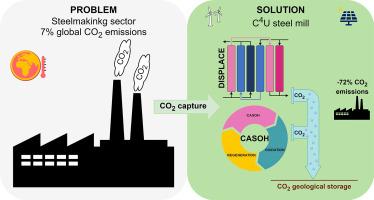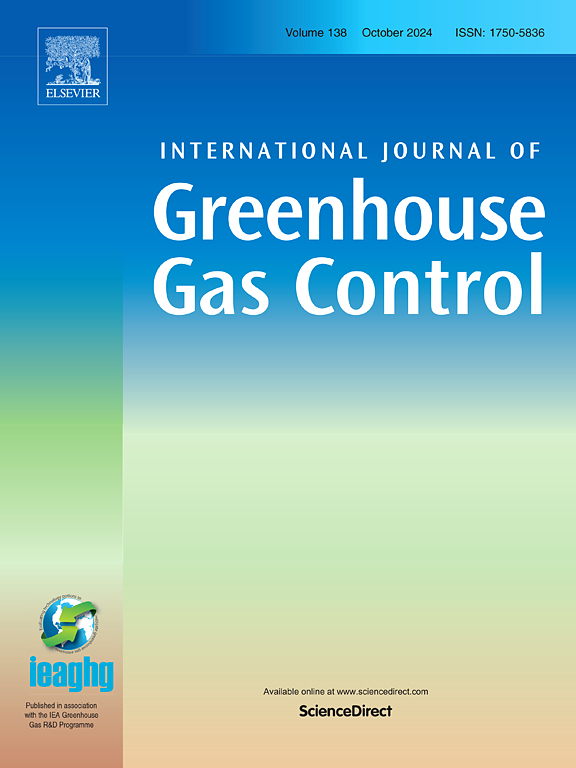将CASOH和displacement技术整合到一家钢铁厂以减少二氧化碳排放——技术经济分析
IF 5.2
3区 工程技术
Q2 ENERGY & FUELS
International Journal of Greenhouse Gas Control
Pub Date : 2025-10-01
DOI:10.1016/j.ijggc.2025.104478
引用次数: 0
摘要
鉴于严重的气候危机和限制全球变暖不利影响的迫切需要,各行各业都需要进行重大变革。其中,钢铁行业是温室气体排放的主要贡献者,约占全球二氧化碳排放量的7%。本研究提出将创新的碳捕获技术,如置换和CASOH,整合到传统的BF-BOF(高炉-碱性氧炉)炼钢工艺中。在Aspen Plus的模拟支持下,进行了全面的技术经济分析,以优化这些技术的集成。该研究建议在BF-BOF钢铁厂内重新设计气体分配系统,结合氧气燃烧装置,以促进燃烧后的碳捕获,并最大限度地减少工厂的排放。分析表明,采用CASOH进行燃烧前CO2捕集,使高炉气和碱性氧炉气的混合物脱碳,结合DISPLACE对热风炉、烧结厂和再热炉的烟气脱碳,CO2排放量减少72%,SPECCA约为0 GJ/tCO2。这在可再生电力的情况下是可以实现的,每吨二氧化碳的成本为138欧元。通过减少废气处理,降低SPECCA和成本,也可以实现更低的二氧化碳避免值。本文章由计算机程序翻译,如有差异,请以英文原文为准。

Integration of CASOH and DISPLACE technologies in a steel plant for the mitigation of CO2 emissions – A techno-economic analysis
Given the severe climate crisis and the urgent need to limit the adverse effects of global warming, drastic changes are required across various industries. Among them, the iron and steel sector is a major contributor to greenhouse gas emissions, accounting for approximately 7 % of global CO2 emissions. This study proposes the integration of innovative carbon capture technologies, such as DISPLACE and CASOH, into a conventional BF-BOF (Blast Furnace-Basic Oxygen Furnace) steelmaking process. A comprehensive techno-economic analysis was conducted, supported by simulations performed in Aspen Plus, to optimize the integration of these technologies. The study suggests a redesigned gas distribution system within the BF-BOF steel plant, incorporating oxy-fired units to facilitate post-combustion carbon capture and minimize the plant emissions. The analysis reveals that, employing CASOH for pre-combustion CO2 capture to decarbonize a mixture of BFG (Blast Furnace Gas) and BOFG (Basic Oxygen Furnace Gas), combined with DISPLACE for decarbonizing flue gases from hot stoves, sinter plant, and reheating ovens, 72 % reduction in CO2 emissions and a SPECCA around 0 GJ/tCO2 can be achieved. This is attainable within a renewable electricity scenario, at a cost of 138 € per ton of CO2 avoided. Lower CO2 avoidance values can also be achieved by treating less exhaust gases with reduction in both SPECCA and costs.
求助全文
通过发布文献求助,成功后即可免费获取论文全文。
去求助
来源期刊
CiteScore
9.20
自引率
10.30%
发文量
199
审稿时长
4.8 months
期刊介绍:
The International Journal of Greenhouse Gas Control is a peer reviewed journal focusing on scientific and engineering developments in greenhouse gas control through capture and storage at large stationary emitters in the power sector and in other major resource, manufacturing and production industries. The Journal covers all greenhouse gas emissions within the power and industrial sectors, and comprises both technical and non-technical related literature in one volume. Original research, review and comments papers are included.

 求助内容:
求助内容: 应助结果提醒方式:
应助结果提醒方式:


